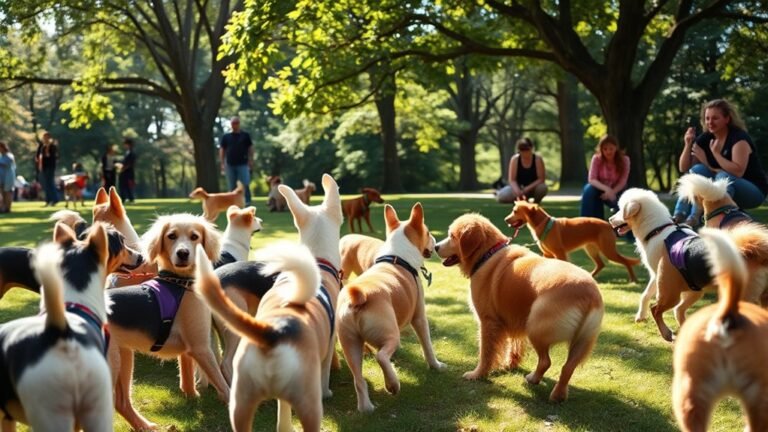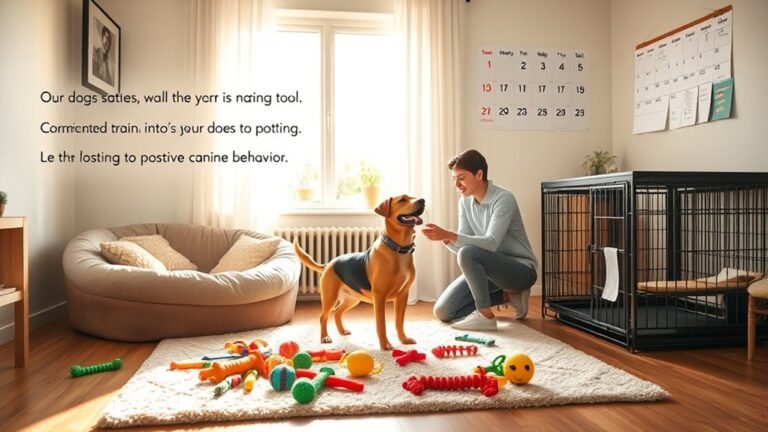Why You Shouldn’t Teach Your Dog to Beg
Teaching your dog to beg might seem fun, but it can cause problems. When dogs beg, they may eat too much and become overweight. This can lead to health issues. Begging can also make dogs feel anxious and unsure. It can mix up what your dog learns and make it harder for you to communicate with them.
So, what can you do instead? Focus on teaching fun, healthy tricks that help your dog feel secure and happy. This will help you both enjoy your time together. Remember, the goal is to build a strong bond with your furry friend!
Key Takeaways
Teaching your dog to beg can cause some health problems. When dogs beg, they might eat more treats. This can lead to weight gain and other issues.
Begging can also make your dog anxious about food. If they worry too much about mealtime, it can harm their mood.
When we let dogs beg, they learn bad manners. They might become too focused on food instead of listening to us.
Begging can make it hard to train your dog. It gets in the way of learning commands.
To help stop begging, feed your dog at regular times. Make sure they get a balanced diet. This helps keep their begging behavior in check.
Understanding Begging Behavior
Dogs beg for food because of their natural instincts and learned habits. They often use their body language, like giving you sad puppy eyes or tilting their heads, to show they want something. These cute actions can pull at your heartstrings, making it tough to say no.
Dogs quickly learn that begging can lead to yummy treats, and this habit can grow stronger over time. In the wild, dogs had to search for food to survive, so their begging behavior comes from this instinct.
To help your dog stop begging, try to understand their feelings. Instead of giving them food every time they ask, focus on teaching positive behaviors.
Spend time with them, play with them, and show them love without using food as a reward. This will help your dog feel secure and loved, and strengthen your bond.
Health Risks Associated With Begging
Letting your dog beg for food might seem cute, but it can actually be bad for their health. If you always give in to their begging, your dog might get overweight. This can lead to serious problems like obesity.
When dogs eat too many treats or unhealthy food, they can get sick in other ways too, like tummy aches or pancreatitis.
When you let your dog beg, it can make them anxious about food. Mealtime should be a happy time, not stressful. To help your furry friend stay healthy, it's best to stick to a regular feeding schedule and say no to begging.
Encouraging Unwanted Habits
Many dog owners don't know that letting their pets beg can create bad habits. These habits are tough to fix and can harm your dog's happiness.
Here's why it matters to stop begging:
- Bad Manners: When dogs beg, they learn it's okay. This makes it hard to change their behavior later.
- Food Obsession: If you encourage begging, your dog may focus too much on food. This isn't healthy.
- Stress: Dogs can get worried if they think they mightn't get food at each meal.
- Social Skills: Begging can make it hard for dogs to get along with other pets and people.
Impact on Training and Communication
Teaching your dog to beg can cause some problems with training and communication. When your dog begs, it sends signals that might mix up your training cues. This confusion can make it harder for your dog to learn and follow commands.
Begging can create misunderstandings and may even hurt your bond with your pet. If you reward begging, it can weaken your training efforts. Keeping clear signals is very important in building trust between you and your dog.
When your dog feels safe and understood, your relationship grows stronger. By focusing on clear commands and avoiding begging, you can have a happier, more respectful bond with your furry friend.
Alternatives to Begging Tricks
If you want to have fun with your dog without making them beg, try teaching some cool tricks!
These tricks can be fun for you and your dog. They help you bond and improve communication.
Here are four tricks to try:
- Shake Hands: Teach your dog to lift their paw and shake with you. It's cute and makes for good bonding time.
- Roll Over: This trick keeps your dog active and helps them follow your commands better. Plus, it's super fun to watch!
- Play Dead: Teach your dog to lie still, like they're playing dead. This trick can impress your friends and sharpen your dog's focus.
- Spin: Get your dog to twirl in circles. It's a fun way to keep their mind sharp and body moving.
Make sure to give them a treat when they learn a trick. This will help them feel happy and accomplished!
Enjoy training your dog!
Reinforcing Negative Behavior Patterns
Teaching your dog fun tricks can help you bond, but some behaviors, like begging, can create problems. When you let your dog beg for food or attention, it encourages this unwanted behavior.
Instead of fixing the problem, you're rewarding the begging, which can make it happen more often. This can lead to stress in your relationship. Your dog may start to think that begging is the way to get what they want.
To build a happy relationship, focus on teaching your dog positive behaviors instead. Show them what you want them to do, and give treats or praise for good actions.
Avoid rewarding begging. Instead, guide your dog to do things that help them feel like they belong. This way, you can create a strong and happy bond with your pet.
The Role of Diet and Portion Control
Understanding how diet and portion control affects your dog is very important. If your dog feels hungry, it might beg for food.
To help stop this, feed your pet a balanced diet with the right amount of food. This will keep them healthy and reduce begging.
Here are some simple tips:
- Find out how many calories your dog needs each day. This depends on your dog's age, weight, and how much they move around.
- Measure your dog's meals to avoid giving too much food. Overfeeding can make your dog overweight.
- Feed your dog at the same times every day. This helps them learn when to expect food, which can calm their hunger.
- You can give your dog small, healthy treats. Just make sure to do this in moderation, so they don't feel too hungry.
Taking care of your dog's diet is a great way to keep them happy and healthy!
Building a Stronger Bond With Your Dog
Feeding your dog a healthy diet helps them stay strong and happy. When you give them the right food and watch how much they eat, you show them you care. This builds trust, making your dog feel safe and loved. They see you as a good leader, which helps your bond grow even stronger.
Doing fun activities together, like going for walks or training, makes your connection even better. These moments help you both understand each other.
Prioritizing your dog's health lets love and loyalty grow. Together, you create a happy life filled with trust and respect. This special partnership makes both of you feel great!
Frequently Asked Questions
Can All Dog Breeds Be Taught to Beg?
Not all dog breeds can learn to beg the same way. Some dogs pick up tricks easily, while others find it harder because of their natural traits and body type.
For example, small breeds like Chihuahuas might be great at begging because they can easily balance on their hind legs. Bigger breeds, like Great Danes, may struggle with this move.
It's important to know your dog's breed and abilities when teaching them tricks. With the right training, many dogs can learn to beg, but results can vary. If your dog isn't getting it right away, keep trying and be patient. Every dog can learn in their own way!
Is Begging a Natural Behavior for Dogs?
Begging is not something dogs do by nature. Instead, dogs learn to beg from their owners. It can be a way for them to communicate, but it's important to know what dogs naturally do. Understanding their natural behaviors helps create better and healthier relationships between you and your dog.
When dogs beg, they often want food or attention. They might sit, paw at you, or look up with big eyes. While it can seem cute, it's a learned habit. Dogs are smart and pick up on what gets them what they want. So, if you give them food when they beg, they think begging works.
To keep things simple, you can teach your dog not to beg. Instead, give your dog treats at set times. This way, they know when to expect food, and begging will decrease. You can also give them a special toy to keep them busy.
How Does Begging Affect My Dog's Confidence?
Begging can hurt your dog's confidence. When dogs beg for food, they start to depend on people for their meals. This dependence can make them feel less secure and less independent. As a result, their overall happiness might decrease.
When a dog doesn't feel confident, it can impact their behavior. They may become anxious or unsure in new situations. It's important to help your dog gain independence. You can do this by setting regular meal times and not giving in to begging.
Instead, focus on showing your dog love and attention in other ways, like playtime or walks. This helps build their confidence and makes them feel more secure. Happy dogs are confident dogs!
Can Begging Lead to Behavioral Issues Later On?
Yes, begging can cause problems for dogs. It may lead to anxiety and dependence on their owners. This is why it is important to show your dog different commands and ways to ask for what they want. Teaching them these skills can make them more confident. It also helps you have a better bond with your dog.
Are There Age Limits for Teaching Dogs Tricks?
You can teach dogs tricks at any age! Puppies are great learners because they are very adaptable. They pick up new things quickly. But don't worry if you have an older dog. Senior dogs can learn too, but you should use gentler methods. This helps them stay comfortable and safe while they learn. So whether your dog is young or old, you can help them learn new tricks!







